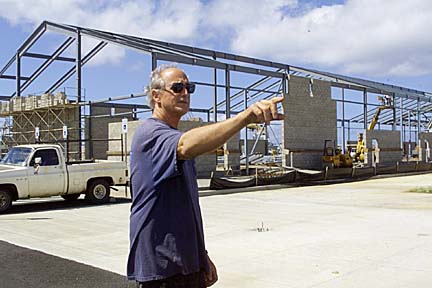


Big money, The state has spent $14.4 million so far to turn Honolulu Harbor's former Pineapple Pier into a fishing "village."
big plans fuel
fishing village
The state and investors
By Diana Leone
are excited about the future
of a robust new development
Star-BulletinAlong 525 feet of a new Pier 38, Hawaii-based commercial fishermen will be able to unload their boats directly to United Fishing Agency, the island's fish auction.
From there, wholesalers who lease space in the village will only need to transport the whole fish they buy at auction a few feet to their processing facilities.
Compared to United Fishing's old, cramped quarters on Ahui Street off Kewalo Basin, it will be much more enticing to the tourist who wants to see ahi, opah and other local fish in the raw.
"I envision folks coming down and buying lunch, looking at the boats and hanging out," said Jim Cook, an active participant in the village idea since its inception 12 years ago.
It is a vision that some say could rival the famous fish markets of Sydney or San Francisco or New York. "I think we should be there, optimistically, in about a year, year and a half," said Frank Goto, United Fishing's longtime general manager. "It's coming, no ifs or buts."

"We will try to induce as many boats as we can to offload to the facility," Goto said. "It will be better for fishermen because they'll have better products to sell."The vision to group fishing-related businesses was formed in the late 1980s, when longline fishing was in a boom-time expansion. Since then an environmental lawsuit on behalf of endangered sea turtles has resulted in the end of Hawaii-based swordfishing and restrictions on tuna longliners.
Industry insiders estimate the recent changes may trim annual fishing industry revenue -- estimated at $50 million a year -- by 40 percent or more.
Still, Hawaii eats two or three times as much fresh fish as mainland states, pointed out Cook, co-owner of five longline boats and the fishing equipment supplier Pacific Ocean Producers and Hawaiian Ice.
Pacific Ocean Producers will build a $2 million, 20,000-square-foot facility at the village by 2002 or 2003 because "we have faith in our market," Cook said.
With United Fishing Agency and Pacific Ocean Producers as anchors, the state hopes that smaller operators will follow and fill out the 16.5-acre village, which is on Department of Transportation land formerly leased by Chevron and Dole.
Transportation Department spokeswoman Marilyn Kali confirmed that the state is negotiating with several potential tenants, but would not name them. Land-only leases are being considered at 23 1/2 cents per square foot per month, she said, and bays in the building will be 45 cents a square foot.
"About five years ago, the federal government set new standards for the seafood business," Cook said, and several businesses that had to upgrade to meet those standards would have been candidates for the village, but it was not far enough along. They will probably stay where they are, he says.
"I think a lot of minds will be changing when they see the potential," Cook said, gesturing along the royal palm-lined promenade along the pier. He points out how the multipurpose building, to be completed in July, and nearby public restrooms have architectural features that go beyond the warehouse look.
In the wake of longlining catch decreases, United Fishing has scaled back its construction plans by half -- opting for a 15,000- to 20,000-square-foot building for $1.5 to $2 million. But that is still double current quarters -- and there will be room for expansion, noted Goto. Like Cook, he remains optimistic about fishing's future.
Mike Irish, president of Diamond Head Seafood Co., said his company was one of those that had to upgrade its old facility before the fishing village was ready.
Whether the company might move there in the future, Irish said, "would depend on the atmosphere of the fish industry at that time. If it looks favorable, it would be a heck of a nice place."
Cheaper leases are likely available elsewhere, and because longline fishermen face reduced income, "people are going to be more cautious," Irish added.
In 1998, Gov. Ben Cayetano asked the Legislature for money to get the project rolling. The original $6 million estimate was upped to $9.6 million when plans for the state to build a multipurpose building, then lease it to smaller tenants, were made. On Friday, Kali could not document exactly when the money was provided for the project. Chevron had to move tanks off the property, and the presence of some jet fuel in the soil had to be checked out by the Health Department before work could move on.
A Health Department spokesman said the 50 to 100 cubic yards of contaminated soil can easily be disposed of safely.
The fishing village's completion will have another development effect. When United Fishing and other land-based, fishing-related businesses are moved out of Kewalo Basin, Cayetano wants to develop that area with an aquarium, University of Hawaii Medical School and more.
State spending on the Fishing Village: Fishing Village building facts
>>$6.5 million: 525 feet of new pier, completed in February by Healy Tibbetts Builders Inc.
>>$4 million: Parking lot, access roads, utility installation, near completion now.
>>$3.9 million: Shell building, 32,000 square feet, to house eight tenants in retail and wholesale fish processing and sales, to be completed in July. Tenants will finish out their own areas inside the building.